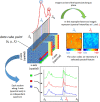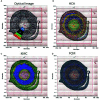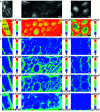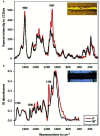Principles and Applications of Vibrational Spectroscopic Imaging in Plant Science: A Review
- PMID: 32849759
- PMCID: PMC7427587
- DOI: 10.3389/fpls.2020.01226
Principles and Applications of Vibrational Spectroscopic Imaging in Plant Science: A Review
Abstract
Detailed knowledge about plant chemical constituents and their distributions from organ level to sub-cellular level is of critical interest to basic and applied sciences. Spectral imaging techniques offer unparalleled advantages in that regard. The core advantage of these technologies is that they acquire spatially distributed semi-quantitative information of high specificity towards chemical constituents of plants. This forms invaluable asset in the studies on plant biochemical and structural features. In certain applications, non-invasive analysis is possible. The information harvested through spectral imaging can be used for exploration of plant biochemistry, physiology, metabolism, classification, and phenotyping among others, with significant gains for basic and applied research. This article aims to present a general perspective about vibrational spectral imaging/micro-spectroscopy in the context of plant research. Within the scope of this review are infrared (IR), near-infrared (NIR) and Raman imaging techniques. To better expose the potential and limitations of these techniques, fluorescence imaging is briefly overviewed as a method relatively less flexible but particularly powerful for the investigation of photosynthesis. Included is a brief introduction to the physical, instrumental, and data-analytical background essential for the applications of imaging techniques. The applications are discussed on the basis of recent literature.
Keywords: FT-IR; Raman; hyperspectral; imaging; multispectral; near-infrared; plant; vibrational spectroscopy.
Copyright © 2020 Beć, Grabska, Bonn, Popp and Huck.
Figures












References
-
- Albani J. R. (2004). Structure and dynamics of macromolecules: absorption and fluorescence studies (Amsterdam, Netherlands: Elsevier Science; ).
-
- Aneece I., Thenkabail P. (2018). Accuracies achieved in classifying five leading world crop types and their growth stages using optimal Earth observing-1 hyperion hyperspectral narrowbands on Google Earth engine. Remote Sens. 10, 2027. 10.3390/rs10122027 - DOI
-
- Arnold T., Leitner R., Bodner G. (2016). Application of NIR hyperspectral imaging for water distribution measurements in plant roots and soil, 2016 IEEE SENSORS (Orlando, FL: IEEE SENSORS; ), 1–3. 10.1109/ICSENS.2016.7808534 - DOI
Publication types
Grants and funding
LinkOut - more resources
Full Text Sources
Miscellaneous

